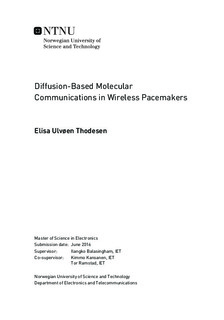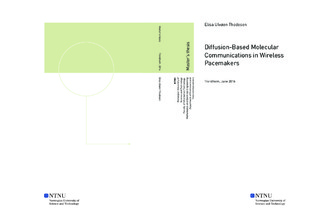| dc.description.abstract | Molecular communications is a novel communication technique that has many advantages over the traditional radio frequency technologies used in body area medical applications. It is based on the body`s own biological communication system. This makes this type of communication biocompatible, which is a huge advantage when the body is the environment. Heart diseases is an increasing problem in the society today. Pacemakers are one option to use for treatment of these type of diseases. The newest development is leadless pacemakers, which improve the performance significantly. Since the mortality of these diseases is high, the importance of having the best medical devices and communication technologies is vital. This report studies the combination of diffusion-based molecular communications and leadless pacemakers. We show that the definition of the concentration of the molecules in pheromone communications, can be transferred to the molecular communications used in pacemakers. A deterministic diffusion-based communication system with this concentration, is first proved a suitable model for the diffusion channel of the communication system. It is then shown that a stochastic Single-Input Single-Output (SISO) communication system with on-off keying as the encoder, a binary hypothesis testing channel and a simplified Neyman Pearson detector, gives good performance for the diffusion-based molecular communication between leadless pacemakers. The most important results leading to this conclusion, is a relatively high capacity of 0,958 bits, a low average error probability (BER) of 0,39 % and low levels of Intersymbol interference (ISI) with the optimal signaling interval of 150 seconds. A stochastic SIMO communication system with the same encoder, channel and decoder, but with Maximum Ratio Combining Diversity, is also evaluated as a suitable communication system for this problem. This approach gives a capacity of 0,23 bits, an average error probability of 0,74 % and low levels of ISI with the optimal signaling interval of 200 seconds. Therefore, the SIMO communication system achieves a lower capacity than the SISO communication system, but is optimal with higher signaling intervals. Last, it is shown that a MIMO communication system with the same encoder, channel and decoder, but with Spatial Multiplexing, is not an optimal alternative for the molecular communication between leadless pacemakers. The reason for this is the significantly lower capacity of 8,47*〖10〗^(-7) bits, a high level of distortion where BER is 24,41 % and a rate distortion that does not match the theory. Even though, the ISI levels are reasonable, it is not sufficient to declare this a suitable communication scheme for molecular communication between leadless pacemakers. | |

